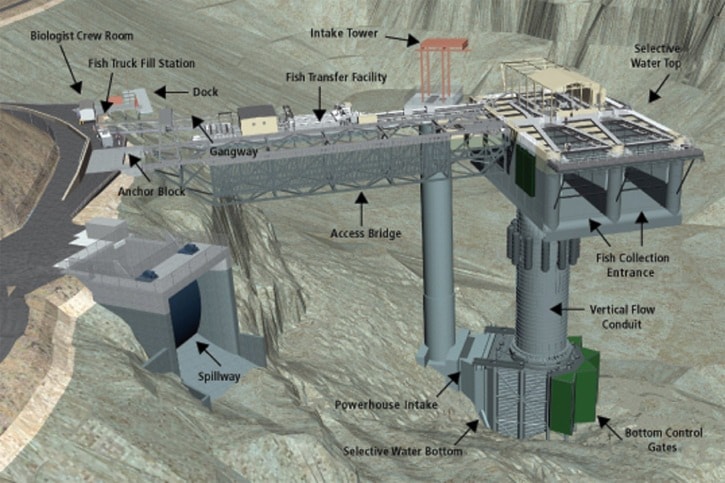Prior to the construction of hydroelectric dams, and human encroachment before that, the Columbia River was one of the most abundant salmon rivers in the world.
An estimated 10 to 15 million (or more) coursed up the river each year, some journeying past Revelstoke, around the Big Bend, and all the way to the Columbia Headwaters near Invermere. Today, about 2.5 million salmon make the abbreviated journey; many are hatchery fish.
The construction of the Grand Coulee Dam in the 1930s and 1940s ended the migration north of that point. Today, the Chief Joseph Dam, just downstream of the Grand Coulee in central Washington State, is the end of the line for salmon migrating up the Columbia.
A new initiative unveiled publicly in Revelstoke last week plans to eventually return the migrating chinook, sockeye and steelhead back to the North Columbia.
Two ‘salmon ambassadors’ visited a Revelstoke Secondary School classroom on Sept. 19, where they pitched the idea to a class studying First Nations issues, planting a seed with the generation who could see the idea through.
Salmo resident Gerry Nellestijn is a streamkeeper trained in cultural anthropology and environmental management. He’s deeply involved in several fish-related organizations, including the Salmo Watershed Streamkeepers’ Society, the Columbia River Round Table, the Upper Columbia White Sturgeon Recovery Initiative and more.
He was in Revelstoke as a ‘salmon ambassador,’ here to introduce the initiative.
He was joined by Nevada Nicholas, also a salmon ambassador, and a lands and resources stewardship assistant for the Ktunaxa Nation.
The goal is to create systems, programs and technological solutions that will allow salmon to bypass the dams. Fish ladders and other systems are in use around the world, but the massive dams of the Columbia, such as the Grand Coulee, Revelstoke and Mica, are a daunting challenge.
(story continues below)

PHOTO: ‘Salmon ambassadors’ Nevada Nicholas and Gerry Nellestijn unveiled the salmon reintroduction concept in Revelstoke last week, part of a regional roll out in the coming weeks. Aaron Orlando/Revelstoke Times Review photo
Solutions could include ladders, mechanical bucketing systems, vacuum systems, trucking or new technologies.
“I hear all about the things that we can’t do,” Nellestijn said. “This is not just about salmon; this is about healthy ecosystems.” He points to the cascading environmental impacts created by the loss of salmon in the Upper Columbia River, which used to see millions of 50-pounders die in the river and on its shores after mating. The epic migration fuelled the regional ecosystem. After they disappeared, “the whole system started to crash,” Nellestijn said.
He points me to the Deschutes Passage project in Oregon, which opened in 2009. The $135-million project by Portland General Electric saw the construction of an 83-metre underwater tower and ramp above the Round Butte Dam, allowing for the collection and transfer of fish downstream.
(Watch a YouTube video explaining the Deschutes Passage project here.)
Nellestijn says it’s an example of a technology-enabled solution (and in fact, the Deschutes Passage replaces a failed salmon bypass system originally installed in the dam when it was completed in 1964.)
It sounds expensive. Who’s going to pay for it? The idea is to link into the Columbia River Treaty (CRT) renewal process. The CRT is an agreement between the US and Canada that coordinates flood control and hydro-electric production on both sides of the border, and is up for possible renegotiation starting in 2024.
Nellestijn explains that First Nations, cooperating through the Canadian Columbia River Inter-Tribal Fisheries Commission, are making the return of salmon a key CRT issue, and they’re rolling out their plans now. Nellestijn also said businesses and organizations that “profit from their use of environmental resources” could help pay.
“This is the single most important opportunity to have an ecological difference in the Upper Columbia River Basin,” Nellestijn said in an interview with the Times Review.
The essential ingredients of a successful reintroduction program, Nellestijn said, are integrated, collaborative, watershed-based strategic planning that shares local, First Nations and technical knowledge, all backed up by a 10-year, guaranteed implementation strategy.
At their Sept. 19 presentation, Nicholas and Nellestijn underscored First Nations intentions to act on the idea, saying they are putting together experiments already (he wouldn’t elaborate.) They said the salmon are the key to many things in the Upper Columbia, including ecological biodiversity and the restoration of traditional cultural and economic practices based on the salmon migration.
A student asked about political will. Is it there? “The First Nations are not going to wait,” Nellestijn said, adding the political will is there amongst the First Nations working on the reintroduction plan.
The plan will be further unveiled at the Columbia Basin Salmon Festival in Invermere on Sept. 28, entitled, ‘The River We Had, The River We Have and the River We Want.”
I ask Nellestijn what are the top three challenges to the reintroduction idea. “Dams, dams and dams,” Nellestijn replied. The fourth, he said, is climate change.
***
What do you think? Do you support the concept? What issues, concerns and challenges do you see? Let us know your feelings about the idea by commenting below.
***
The following video explains the Deschutes Passage project in Oregon, an innovative facility that allows salmon to bypass a dam there:
